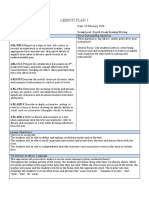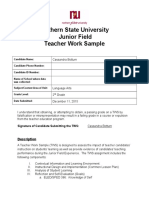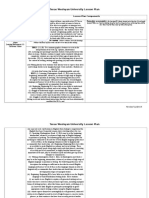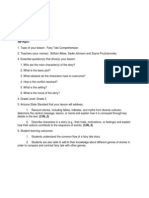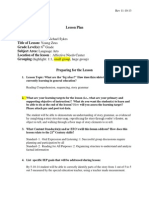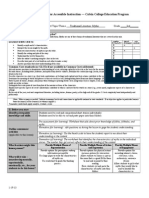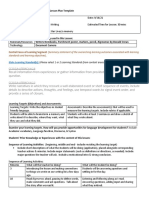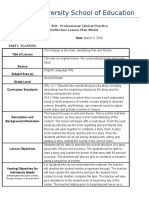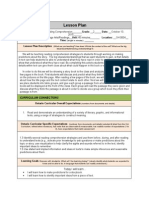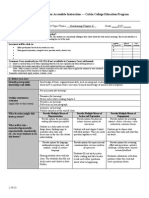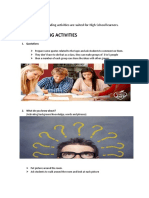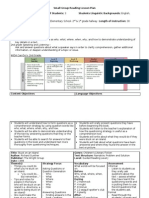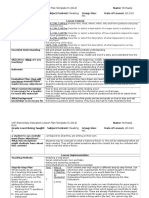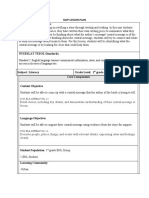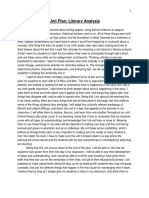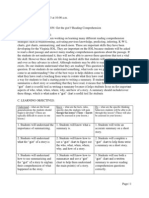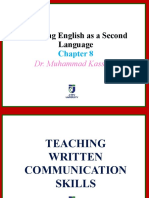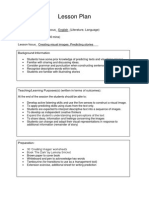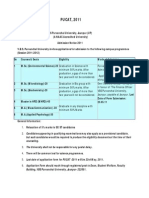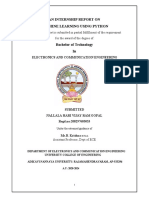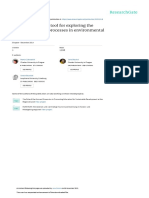Shared Reading Week of 0127
Shared Reading Week of 0127
Uploaded by
api-241777721Copyright:
Available Formats
Shared Reading Week of 0127
Shared Reading Week of 0127
Uploaded by
api-241777721Original Title
Copyright
Available Formats
Share this document
Did you find this document useful?
Is this content inappropriate?
Copyright:
Available Formats
Shared Reading Week of 0127
Shared Reading Week of 0127
Uploaded by
api-241777721Copyright:
Available Formats
Shared Reading
January 27, 2014
1. Lesson Goals Essential Question/Big Idea: 1. Students can retell familiar stories, including key details of informational text, with support. (RL.K.2) - How can you retell the story using the important parts from the beginning, middle, and end? 2. Students can recognize and produce rhyming words. (RFS.K.2a) - How does rhyming support students in their ability to read? Objectives: SWBAT - Retell the main event from a story read aloud (BME). - Identify elements of story including setting, character, and key events. - Recognize and produce rhyming words. Why have you chosen these objectives? 1. Retelling is one of the foundational skills that students need to learn and develop in, so that it can help them with their reading comprehension. 2. The ability to recognize and produce rhyming words is a foundational skill in understanding word structure and its role in reading and writing. Standards: - CCSS.ELA-Literacy.RL.K.2 With prompting and support, retell familiar stories, including key details. - CCSS.ELA-Literacy.RL.K.3 With prompting and support, identify characters, settings, and major events in a story. - CCSS.ELA-Literacy.RF.K.2a Recognize and produce rhyming words.
2. Content Knowledge Students will be reading a book called, Milwaukee Cows by Joy Cowley and illustrated by John Bennett. The purpose of reading this book is to have students identify which words rhyme. Also, the purpose the reading this book is to have students recall what each Milwaukee cow did outside the farm. It is important for students to learn this concept (retelling) because they build on their knowledge of recalling important details. When students learn to retell, they can use the knowledge to write a story and build comprehension. Also, retelling information requires students to listen and be able to tell a story in a logical sequence. Misconceptions: students retelling the story might turn into a summary. Retelling and summary are not the same thing! Retelling is an oral activity in which a reader explains the main ideas of the text. After reading a story, students should be able to retell the story by putting it into his/her own words. Summarizing is a written activity in which the writer writes only the most important details from the story. It is also important for students recognize and produce rhyming words because it helps them develop phonemic awareness, which facilitates decoding. It also teaches students to make connections between categories and the patterns that are used to spell words. 3. Levels of Differentiation How does your lesson connect to the interests and cultural backgrounds of your students? Retelling requires students to not only listen, it also requires them to talk. This can help students who are mostly silent because it can increase their social skills through literacy activities.
How will you differentiate instruction for students who need additional content support during this lesson? For students who need additional content support, I will have pictures ready from the book that will help them recall what they remember from the story. These pictures will have information from the book so that they can correlate the sentences to the picture. How will you differentiate instruction for students who need additional language support during this lesson? For students who need additional language support, they can sit next to a student who can guide them and answer questions at any point in the class in a discreet manner as possible. Also, I can use a visual or pictures from the book while speaking that reinforces what I am saying. For this lesson, I will be referring to the pictures in the book when the students and I go review the story. How will you differentiate instruction for students who need additional challenge during this lesson? For students who need additional challenge, I can ask open-ended questions that do not require a correct answer (creative thinking). For this lesson, I can ask these students to think of other reasons why the Milwaukee cows are in Hollywood and what they think the cows will do there. These students can write a story or draw a picture of the cows doing something Hollywood.
4. Methods What teaching method(s) will you use for this lesson? The Five Finger Retelling: 1. Who/what was the story about? 2. Where did it take place? 3. What happened in the beginning? 4. What happened in the middle? 5. What happened at the end of the story? Why have you chosen this method or these methods? This strategy can help students remember what they need to think about when retelling a story/information.
5. Activities (Make sure all materials are ready before the lesson begins!) 1. Before reading the book, have the students pick a partner closest to them (shoulder partner or someone in front of them). If students are having difficulties picking/finding a partner, pick one for them. [30 seconds] 2. Tell students that they will be reading this book to recall what happened in the beginning, middle, and end. Also, tell students they need to listen to the words carefully because there are rhyming words that they need to identify. [1 minute] 3. Ask, What comes first in the story: beginning, middle, or end? Read the beginning part of the story and ask students questions from the sticky note (if any). Also, ask students if they heard any rhyming words and use highlighting tape to highlight the words. After reading the beginning part, show students an anchor chart that has the letters B, M, and E. Explain to them that as they read, they will retell what happened in the beginning, middle, and end of the story. As they retell the story, their responses will be recorded so that it can help them remember the story. Also, I will draw a quick sketch for each section. Then, have the students turn and talk to their partner about what happened in the beginning. Give students about 15 seconds. As students are talking, listen to some of their conversation. This will help me to know if the students comprehend the story. Then pick 3 students what they said to their partner and write their response on an anchor chart. Repeat this for the middle and end of the book. [7-10 minutes]
4. At the end of the story, remind students that they read this book to retell the story. Go over the anchor chart as a class from the beginning to the end. [1-2 minutes] 5. Explain to the students that they will be given a blank sheet of paper that has the letters B, M, and E. Tell them what those letters mean, again. Instruct students that will need to recall what happened in the beginning, middle, and end of the story by drawing a picture. Also tell students to label their pictures. [10-15 minutes] 6. Materials: Milwaukee Cows by Joy Cowley, illustrated by John Bennett Camera Highlighting tape Markers Anchor chart with the letters B, M, and E: retelling Blank paper (18) 7. Evaluation Plan: Before reading: I will ask students what the story is going to be about. This will help me understand if the students are able to make connections between the title of the book and picture on the front cover. Also, I want to see if they make connections between new information and what they already know. During reading: I will stop in the middle of the book and ask students questions regarding the book. This will help me know if the students comprehend and if they are using the pictures to help them answer the question (p. 3, 6, 8). I will also ask students if they heard any rhyming words. As for turn-and-talk, I will listen to their responses to see if they recall the beginning, middle, and end of the story. End of reading: Students and I will go over the responses written on the anchor chart. Students will then return to their seats and will recall what happened in the beginning, middle, and end of the story by draw a picture and labeling them. Students work will be collected. 8. Resources http://www.corestandards.org/ELA-Literacy/RF/K http://www.howtolearn.com/2012/01/rhyming-improves-reading-spelling-writing/ http://www.liketoread.com/retell.html
Shared Reading
January 28-29, 2014
2. Lesson Goals Essential Question/Big Idea: 1. Students can retell familiar stories, including key details of informational text, with support. (RL.K.2) - How can you retell the story using the important parts from the beginning, middle, and end? 2. Students can recognize and produce rhyming words. (RFS.K.2a) - How does rhyming support students in their ability to read? Objectives: SWBAT - Retell the main event from a story read aloud (BME). - Identify elements of story including setting, character, and key events. - Recognize and produce rhyming words. Why have you chosen these objectives? 1. Retelling is one of the foundational skills that students need to learn and develop in, so that it can help them with their reading comprehension. 2. The ability to recognize and produce rhyming words is a foundational skill in understanding word structure and its role in reading and writing. Standards: - CCSS.ELA-Literacy.RL.K.2 With prompting and support, retell familiar stories, including key details. - CCSS.ELA-Literacy.RL.K.3 With prompting and support, identify characters, settings, and major events in a story. - CCSS.ELA-Literacy.RF.K.2a Recognize and produce rhyming words.
2. Content Knowledge Students will be reading a book called, The Scrubbing Machine by Joy Cowley and illustrated by Elizabeth Fuller. The purpose of reading this book is to have students identify which words rhyme. Also, the purpose the reading this book is to have students recall what the scrubbing machine scrubbed in the beginning, middle, and end of the story. Students will also recall what Mrs. Wishy-Washy did in the beginning of the story and what she tried to do in the middle and at the end of the story. (Day 1): While reading half the story (the book is too long for one day), students will be asked questions regarding the book, especially the names of the characters and retelling what happened in the beginning and middle). Students will also need to identify rhyming words in the story. (Day 2): The second part of the story will be read. Students will need to know the names of the characters (if any) as the story is being read to them. While the teacher is reading the book, she will stop and ask students questions about the names of the characters mentioned in the book and what happened so far in the story. Students will also need to identify rhyming words in the story. Students need to understand that rhyming words are words with similar sounds even if the last couple letters are not spelled the same (Example: four and door). Some rhyming words may have the same last letters, but its mostly about whether the words sound the same. It is also important for students recognize and produce rhyming words because it helps them develop phonemic awareness, which facilitates decoding. It also teaches students to make connections between categories and the patterns that are used to spell words.
It is important for students to learn this concept (retelling) because they build on their knowledge of recalling important details. When students learn to retell, they can use the knowledge to write a story and build comprehension. Also, retelling information requires students to listen and be able to tell a story in a logical sequence. Misconceptions: students retelling the story might turn into a summary. Retelling and summary are not the same thing! Retelling is an oral activity in which a reader explains the main ideas of the text. After reading a story, students should be able to retell the story by putting it into his/her own words. Summarizing is a written activity in which the writer writes only the most important details from the story. 3. Levels of Differentiation How does your lesson connect to the interests and cultural backgrounds of your students? Retelling requires students to not only listen, it also requires them to talk. This can help students who are mostly silent because it can increase their social skills through literacy activities. How will you differentiate instruction for students who need additional content support during this lesson? For students who need additional content support, I will have pictures ready from the book that will help them recall what they remember from the story. These pictures will have information from the book so that they can correlate the sentences to the picture. How will you differentiate instruction for students who need additional language support during this lesson? For students who need additional language support, they can sit next to a student who can guide them and answer questions at any point in the class in a discreet manner as possible. Also, I can use a visual or pictures from the book while speaking that reinforces what I am saying. For this lesson, I will be referring to the pictures in the book when the students and I go review the story. How will you differentiate instruction for students who need additional challenge during this lesson? For students who need additional challenge, I can ask open-ended questions that do not require a correct answer (creative thinking). For this lesson, I can ask these students why Mrs. Wishy-Washy didnt take the scrubbing machine with her when she left the shop and if they think Mrs. Wishy-Washy was happy with the scrubbing machine. Students can write their response or write a story.
4. Methods What teaching method(s) will you use for this lesson? The Five Finger Retelling: 1. Who/what was the story about? 2. Where did it take place? 3. What happened in the beginning? 4. What happened in the middle? 5. What happened at the end of the story? Why have you chosen this method or these methods? This strategy can help students remember what they need to think about when retelling a story/information.
5. Activities Day 1: (Make sure all materials are ready before the lesson begins!) 1. Half the story will be read on the first day. Students will need to know the name of the character and the details in the story. While reading, ask the questions on the yellow sticky notes: p. 3 and 7. Also, have the students read the highlight words (point to the pictures if necessary). After the beginning part
of the book is read, have the students turn and talk to the same partner they talked to the day before about what happened in the beginning. Repeat for the middle part of the story. [10 minutes] 2. After the story is read, have the students turn and face the whiteboard easel. Students and I will go over the meaning of rhyming, the action, and the 5 Finger Retelling method. [1-2 minutes] 3. Read the story from the anchor chart. Tell students that they will identify rhyming words. Read each paragraph to students and have a student circle the rhyming words. Provide students different colored markers so that each pair of rhyming words will be one color. [5-7 minutes] Day 2: (Make sure all materials are ready before the lesson begins!) 1. Have a brief discussion about the first half of the story with the students. After reviewing, tell the students that they will read the rest of the book and find out what other things the scrubbing machine scrubbed. [1-2 minutes] 2. Read and finish the second portion of the book. Students will need to know the names of the characters and the details in order to retell the story in their own words. While reading, ask the questions on the yellow sticky notes: p. 13 and 16. Also, have the students read the words the highlighted words (point to the words). [7-10 minutes] 3. After the story is read, have the students turn and face the whiteboard easel. Students and I will briefly go over the meaning of rhyming, the action, and the 5 Finger Retelling method. [1-2 minutes] 4. Read the second half of story from the anchor chart. Tell students that they will identify rhyming words. Read each paragraph to students and have a student circle the rhyming words. Provide students different colored markers so that each pair of rhyming words will be one color. [5-7 minutes]
6. Materials: Day 1: The Scrubbing Machine by Joy Cowley, illustrated by Elizabeth Fuller Camera Scotch Tape Anchor chart: rhyming words Different colored markers Day 2: The Scrubbing Machine by Joy Cowley, illustrated by Elizabeth Fuller Camera Scotch Tape Anchor chart: rhyming words Different colored markers 7. Evaluation Plan: (Day 1): Before reading: Read the title and the names of the author and illustrator. Ask them what the author and the illustrator does. Go over the features of the book. Then ask students what they think the story is going to be about. This will help me understand if the students are able to make connections between the title of the book and picture on the front cover. Also, I want to see if they make connections between new information and what they already know. During reading: I will stop on some pages to ask students questions regarding the book. This will help me know if the students comprehend (p. 3 and 7). Also, students will read the words highlighted on each page. After reading the beginning and middle of the story, students will turn and talk to their partners and retell the story in their own words. I will be listening to their responses and asking them questions. Stop in the middle of the book (stopping point).
End of reading: I will read the same story again, but from the anchor chart. Students will identify rhyming words in the story and circle them.
(Day 2): Before reading: Students and I will review the first half of the story together. I will then have the students wonder what the scrubbing machine will scrub. This strategy is important for students before, during, and after they read any books because it can assist them to comprehend the text. This strategy also provides a framework for active reading and engagement as students go in search for the answers. Read the second half of the story. During reading: I will stop on some pages to ask students questions regarding the book. This will help me know if the students comprehend (p. 13 and 16). Also, students will read the words highlighted on each page. After reading the beginning and middle of the story, students will turn and talk to their partners and retell the story in their own words. I will be listening to their responses and asking them questions. End of reading: Briefly go over what the students did the day before and what words were circled. I will read the second half of the story again, but from the anchor chart. Students will then identify rhyming words in the story and circle them. 8. Resources http://www.corestandards.org/ELA-Literacy/RF/K http://www.howtolearn.com/2012/01/rhyming-improves-reading-spelling-writing/ http://www.liketoread.com/retell.html http://www.pdst.ie/sites/default/files/latest_1.pdf
Shared Reading
January 31, 2014
3. Lesson Goals Essential Question/Big Idea: 1. Students can retell familiar stories, including key details of informational text, with support. (RL.K.2) - How can you retell the story using the important parts from the beginning, middle, and end? 2. Students can recognize and produce rhyming words. (RFS.K.2a) - How does rhyming support students in their ability to read? Objectives: SWBAT - Retell the main event from a story read aloud (BME). - Identify elements of story including setting, character, and key events. - Recognize and produce rhyming words. Why have you chosen these objectives? 1. Retelling is one of the foundational skills that students need to learn and develop in, so that it can help them with their reading comprehension. 2. The ability to recognize and produce rhyming words is a foundational skill in understanding word structure and its role in reading and writing. Standards: - CCSS.ELA-Literacy.RL.K.2 With prompting and support, retell familiar stories, including key details. - CCSS.ELA-Literacy.RL.K.3 With prompting and support, identify characters, settings, and major events in a story. - CCSS.ELA-Literacy.RF.K.2a Recognize and produce rhyming words.
2. Content Knowledge Students will be reading a book called, The Very Hungry Caterpillar by Eric Carle. The purpose of reading this book is to have students think of words that rhyme with one word from the story (cake). Students will be given a sheet of paper, and they will think of 3 words that rhyme with cake. Also, the purpose the reading this book is to have students recall what the caterpillar ate in the story. It is important for students to learn this concept (retelling) because they build on their knowledge of recalling important details. When students learn to retell, they can use the knowledge to write a story and build comprehension. Also, retelling information requires students to listen and be able to tell a story in a logical sequence. Misconceptions: students retelling the story might turn into a summary. Retelling and summary are not the same thing! Retelling is an oral activity in which a reader explains the main ideas of the text. After reading a story, students should be able to retell the story by putting it into his/her own words. Summarizing is a written activity in which the writer writes only the most important details from the story. It is also important for students recognize and produce rhyming words because it helps them develop phonemic awareness, which facilitates decoding. It also teaches students to make connections between categories and the patterns that are used to spell words. 3. Levels of Differentiation How does your lesson connect to the interests and cultural backgrounds of your students? Retelling requires students to not only listen, it also requires them to talk. This can help students who are mostly silent because it can increase their social skills through literacy activities.
How will you differentiate instruction for students who need additional content support during this lesson? For students who need additional content support, I will have pictures ready from the book that will help them recall what they remember from the story. These pictures will have information from the book so that they can correlate the sentences to the picture. How will you differentiate instruction for students who need additional language support during this lesson? For students who need additional language support, they can sit next to a student who can guide them and answer questions at any point in the class in a discreet manner as possible. Also, I can use a visual or pictures from the book while speaking that reinforces what I am saying. For this lesson, I will be referring to the pictures in the book when the students and I go review the story. How will you differentiate instruction for students who need additional challenge during this lesson? For students who need additional challenge, I can ask open-ended questions that do not require a correct answer (creative thinking). For this lesson, I can ask these students to continue the story in their own words on what the butterfly will do next.
4. Methods What teaching method(s) will you use for this lesson? The Five Finger Retelling: 1. Who/what was the story about? 2. Where did it take place? 3. What happened in the beginning? 4. What happened in the middle? 5. What happened at the end of the story? Why have you chosen this method or these methods? This strategy can help students remember what they need to think about when retelling story/information.
5. Activities (Make sure all materials are ready before the lesson begins!) 1. Before reading the book, have the students pick a partner closest to them (shoulder partner or someone in front of them). If students are having difficulties picking/finding a partner, pick one for them. [30 seconds] 2. Go over The Five Finger Retelling poster. Tell students that they will be reading this book to recall what happened in the beginning, middle, and end. (We will read this book to see what happened to the caterpillar in the beginning, what he ate in the middle, and what happened at the end of the story). [1 minute] 3. Ask, What comes first in the story: beginning, middle, or end? Read the beginning part of the story and ask students questions from the sticky note. Explain to them that as they read, they will retell what happened in the beginning, middle, and end of the story to their partner. [30 seconds] 4. Have the students turn and talk to their partner about what happened in the beginning. Give students about 15 seconds. As students are talking, listen to some of their conversation. This will help me to know if the students comprehend the story. Repeat this for the middle and end of the book. [7-10 minutes] 5. At the end of the story, remind students that they read this book to retell the story. 6. Move on to rhyming. Open the book to pages 15-16 and re-read that page. Point to the word cake. Tell students that they will rhyme with this word. Show students the word on a construction paper. Cover the letter C and have the students sound out the letters a and k (point to the letters). Tell students that the letter e is silent. Once they figure out the sound -ake makes, uncover the letter C and have them put the word together. Have the students repeat the word twice.
7. Tell students that they will write down three words that rhyme with cake. Show students the paper that they will be writing on. [5 minutes] 8. Before students return to their seats, give them directions: - Write your name at the top of the paper. Think of three words that rhyme with cake and write them on the blank (point to it). When you are finished, raise your hand quietly, and I will ask you to tell me the three words youve written. After I collect your paper, I want to take out your books and read to yourselves. If I see you are reading to yourselves, I will tell you to pick a partner to read with. I will also call on some of you to go on the computer. 6. Materials: The Very Hungry Caterpillar by Eric Carle Camera Worksheet (Rhyming with the word cake) [19] Sticky notes: - Page 5: Who is the character in the story? // Turn and talk: have the students discuss what happened in the beginning of the story. - Page 18: What happened to the caterpillar after he ate so much food? How did he feel after eating the green leaf? // Turn and talk: have the students discuss what happened in the middle of the story. - Page 22: What happened to the caterpillar? // Turn and talk: have the students discuss what happened at the end of the story. The Five Finger Retelling poster 7. Evaluation Plan: Before reading: I will ask students what the story is going to be about. This will help me understand if the students are able to make connections between the title of the book and picture on the front cover. Also, I want to see if they make connections between new information and what they already know. During reading: I will stop in the middle of the book and ask students questions regarding the book. This will help me know if the students comprehend the story. As for turn-and-talk, I will listen to their responses to see if they recall the beginning, middle, and end of the story. End of reading: Students and I will re-read pages 15-16. I will point to the word cake and tell students that they will rhyme with this word. Students will be provided a handout for them to write on. They will write three words that rhyme with cake. This short assignment will determine whether or not they know how to rhyme. 8. Resources http://www.corestandards.org/ELA-Literacy/RF/K http://www.howtolearn.com/2012/01/rhyming-improves-reading-spelling-writing/ http://www.liketoread.com/retell.html
You might also like
- Revised Summarizing LessonsDocument25 pagesRevised Summarizing Lessonsapi-251432137No ratings yet
- Childrens Lit Unit and Lesson PlansDocument18 pagesChildrens Lit Unit and Lesson Plansapi-384819868No ratings yet
- Lesson Plan 1 Retelling Fairytale NewsDocument5 pagesLesson Plan 1 Retelling Fairytale Newsapi-248976520No ratings yet
- Vocabulary: Wolf, Villagers, Hill, SheepDocument53 pagesVocabulary: Wolf, Villagers, Hill, SheepMelissa MorrisNo ratings yet
- Northern State University Junior Field Teacher Work Sample: DescriptionDocument8 pagesNorthern State University Junior Field Teacher Work Sample: Descriptionapi-300518953No ratings yet
- Texas Wesleyan University Lesson Plan: Domain-DimensionsDocument4 pagesTexas Wesleyan University Lesson Plan: Domain-Dimensionsapi-340630807No ratings yet
- Eed 531 TipjohnsonalbeepruzhanovskyDocument9 pagesEed 531 Tipjohnsonalbeepruzhanovskyapi-242540582No ratings yet
- Literacy Lesson Plan 2Document4 pagesLiteracy Lesson Plan 2api-253457129No ratings yet
- Lesson 1Document3 pagesLesson 1api-245823147No ratings yet
- Mopta Lesson Plan Template Standards/Quality Indicators/SkillsDocument7 pagesMopta Lesson Plan Template Standards/Quality Indicators/Skillsapi-385766083No ratings yet
- Eds 332 Lesson 2Document10 pagesEds 332 Lesson 2api-297788513No ratings yet
- Week 4Document56 pagesWeek 4Melissa MorrisNo ratings yet
- Immersion Week 1 - Reading Lesson 1Document3 pagesImmersion Week 1 - Reading Lesson 1api-235237171No ratings yet
- Myths LessonDocument3 pagesMyths Lessonapi-300649730No ratings yet
- Thematic Unit - Literacy Lesson PlanDocument3 pagesThematic Unit - Literacy Lesson Planapi-528736424No ratings yet
- Nonfiction Science W ReflecDocument6 pagesNonfiction Science W Reflecapi-249238099No ratings yet
- Writing Lesson Plan and ReflectionDocument3 pagesWriting Lesson Plan and Reflectionapi-577230763No ratings yet
- Literacy Lesson PlanDocument3 pagesLiteracy Lesson Planapi-266569607No ratings yet
- Here Are The Seven Must Teach Comprehension StrategiesDocument8 pagesHere Are The Seven Must Teach Comprehension StrategiesBashar AhmadNo ratings yet
- Reflective Lesson Plan-ElaDocument13 pagesReflective Lesson Plan-Elaapi-217594944No ratings yet
- Lesson Plan: Curriculum ConnectionsDocument8 pagesLesson Plan: Curriculum Connectionsapi-295933754No ratings yet
- Monday: Teacher: Week Of: Students: Friday Assessment: Book Title: DRA Level: Take Home Book TitleDocument8 pagesMonday: Teacher: Week Of: Students: Friday Assessment: Book Title: DRA Level: Take Home Book TitleAngela Votaw MillerNo ratings yet
- Lesson 3Document3 pagesLesson 3api-245823147No ratings yet
- Story Elements SSNDocument4 pagesStory Elements SSNapi-222112257No ratings yet
- Read Aloud Lesson PlanDocument6 pagesRead Aloud Lesson Planapi-349922174No ratings yet
- TP Task - Task 3Document11 pagesTP Task - Task 3api-302003110No ratings yet
- Unit Plan Main IdeaDocument16 pagesUnit Plan Main IdeaGreta LautenschuetzNo ratings yet
- Pre-Reading Activities: The Following Reading Activities Are Suited For High School LearnersDocument22 pagesPre-Reading Activities: The Following Reading Activities Are Suited For High School LearnersJunna Gariando BalolotNo ratings yet
- Dunn Pe4 Acei 3 2 FinalDocument27 pagesDunn Pe4 Acei 3 2 Finalapi-268415504No ratings yet
- Smallgroup Lesson PlanDocument7 pagesSmallgroup Lesson PlanJuanita Castro BarreraNo ratings yet
- Lesson 3Document3 pagesLesson 3api-515018928No ratings yet
- Main Idea Lesson TemplateDocument4 pagesMain Idea Lesson Templateapi-275591103No ratings yet
- Edtpa-Aligned Lesson For All ClassesDocument12 pagesEdtpa-Aligned Lesson For All Classesapi-267736442No ratings yet
- How To Work With ReadingDocument5 pagesHow To Work With ReadingAlinfa1No ratings yet
- 2 11 Aunt SusanDocument4 pages2 11 Aunt Susanapi-308910909No ratings yet
- Siop Lesson Plan - ElementaryDocument8 pagesSiop Lesson Plan - Elementaryapi-547615210No ratings yet
- Lesson Number ThreeDocument3 pagesLesson Number Threeapi-284181679No ratings yet
- Highlight Relevant Parts of The Standards That Relate Directly To Your Lesson ObjectivesDocument4 pagesHighlight Relevant Parts of The Standards That Relate Directly To Your Lesson Objectivesapi-283979987No ratings yet
- Unit Plan Assignment 2Document13 pagesUnit Plan Assignment 2api-313149031No ratings yet
- Sample Student Lesson Plan 2220Document5 pagesSample Student Lesson Plan 2220breefrickNo ratings yet
- Reading Comprehension Lesson Plan FinalDocument9 pagesReading Comprehension Lesson Plan Finalapi-254917183No ratings yet
- HLT3701 ExamDocument8 pagesHLT3701 ExamAmor NelNo ratings yet
- Curriculm MapDocument11 pagesCurriculm Mapapi-316343255No ratings yet
- Lesson 5Document3 pagesLesson 5api-302454223No ratings yet
- Teaching English As A Second Language: Dr. Muhammad KassimDocument37 pagesTeaching English As A Second Language: Dr. Muhammad KassimFarah Zein EddinNo ratings yet
- UNT Lesson Plan Template: Janice Tippett 5 Farmers Branch Elementary/Cathy SandersDocument4 pagesUNT Lesson Plan Template: Janice Tippett 5 Farmers Branch Elementary/Cathy SandersJanice Nichole TippettNo ratings yet
- Guided Reading - Dra AssignmentDocument7 pagesGuided Reading - Dra Assignmentapi-286060600No ratings yet
- Strategy Lesson 1Document5 pagesStrategy Lesson 1api-484708169No ratings yet
- PreK - Reading Enrichment Lesson PlanDocument8 pagesPreK - Reading Enrichment Lesson PlanBecky Bohler AlfordNo ratings yet
- Ex Lesson Document Camera 1Document4 pagesEx Lesson Document Camera 1api-309168780No ratings yet
- Main Idea UbdDocument12 pagesMain Idea Ubdapi-253205044No ratings yet
- Picture Book Lesson PlanDocument2 pagesPicture Book Lesson Planapi-508716116100% (1)
- Literacy Lesson ExemplarDocument6 pagesLiteracy Lesson Exemplarapi-734234347No ratings yet
- Social Justice Lesson PlanDocument14 pagesSocial Justice Lesson Planapi-314247862No ratings yet
- 442 lp2Document9 pages442 lp2api-222110053No ratings yet
- Unit Plan Lesson 3Document3 pagesUnit Plan Lesson 3api-338231293100% (1)
- Standards Based Lesson Plan - Individual Lesson: Intern: Krista Guest Grade Level: 3Document8 pagesStandards Based Lesson Plan - Individual Lesson: Intern: Krista Guest Grade Level: 3api-345657735No ratings yet
- Direct Instruction Lesson Plan TemplateDocument5 pagesDirect Instruction Lesson Plan Templateapi-282143950No ratings yet
- Lesson Plan Primary 2Document4 pagesLesson Plan Primary 2api-263117400100% (1)
- ImechE App Form Academic Review v5INTex 2Document3 pagesImechE App Form Academic Review v5INTex 2Amir O. Osho0% (1)
- Đề 5Document19 pagesĐề 5thuytrang172006No ratings yet
- Analysis of Expansion Joint - A Case StudyDocument9 pagesAnalysis of Expansion Joint - A Case StudyIJRASETPublicationsNo ratings yet
- Rubric For Oral ExamDocument1 pageRubric For Oral ExamMigue Ulmētum100% (1)
- Lesson-11: Perception: 1. Learning OutcomeDocument14 pagesLesson-11: Perception: 1. Learning Outcomearjun SinghNo ratings yet
- Linaya 21003325 A1 C PaDocument6 pagesLinaya 21003325 A1 C Paapi-725946959No ratings yet
- Sage Char-Lee Letter of Recomendation 2Document1 pageSage Char-Lee Letter of Recomendation 2api-510197139No ratings yet
- 1st HRPTA Meeting PPT 2024Document24 pages1st HRPTA Meeting PPT 2024Aiza Mae PanteNo ratings yet
- How To Succeed As An Artist - A Step by Step Guide - CAIDocument21 pagesHow To Succeed As An Artist - A Step by Step Guide - CAIVinit GuptaNo ratings yet
- Action VerbsDocument1 pageAction Verbsmarco ocampo0% (1)
- Ass AsDocument2 pagesAss AsMukesh BishtNo ratings yet
- A Detailed Lesson PlanDocument13 pagesA Detailed Lesson PlanCharrie Mae MarcosNo ratings yet
- Jyan Shar ReportDocument48 pagesJyan Shar ReportTorreus AdhikariNo ratings yet
- Scholarship Workshop HandoutDocument5 pagesScholarship Workshop Handoutapi-228991062No ratings yet
- English LP Bac2017 CorrectionDocument2 pagesEnglish LP Bac2017 CorrectionAlaa Eddine NouiNo ratings yet
- Chapter-3 Life Sketch of KautilyaDocument25 pagesChapter-3 Life Sketch of KautilyaHema PenmatsaNo ratings yet
- Theory Paper - Expectancy Violations Theory PDFDocument4 pagesTheory Paper - Expectancy Violations Theory PDFapi-407551243No ratings yet
- Financial PerformanceDocument13 pagesFinancial PerformanceTamara TantartoNo ratings yet
- Final LastDocument34 pagesFinal LastakhilNo ratings yet
- Discussion Guide Six Dots FINALDocument3 pagesDiscussion Guide Six Dots FINALSimi RaffyNo ratings yet
- Open-Ended Laboratory (Oel) : Eat 303 Wastewater EngineeringDocument21 pagesOpen-Ended Laboratory (Oel) : Eat 303 Wastewater EngineeringKucing GemukNo ratings yet
- SBFP Forms 1 6Document25 pagesSBFP Forms 1 6Mindalyn Muring AripNo ratings yet
- Adler (2011) Combining - Collaborative CreativeDocument23 pagesAdler (2011) Combining - Collaborative Creativebherrera1No ratings yet
- Ampit Tt2 Lesson PlanDocument11 pagesAmpit Tt2 Lesson Planrosanie alas-asNo ratings yet
- Bafin 102 - International Business and TradeDocument8 pagesBafin 102 - International Business and TradeAirah Jane TiglaoNo ratings yet
- Cluster University Jammu: Title: Psychology in EducationDocument2 pagesCluster University Jammu: Title: Psychology in EducationChaitanya Shekhar 711No ratings yet
- Actor Analysis As A Tool For Exploring The Decision-Making Processes in Environmental Gover...Document48 pagesActor Analysis As A Tool For Exploring The Decision-Making Processes in Environmental Gover...rizkyNo ratings yet
- English 2 q3 Mod8 Participating in Choral Speaking and Echo ReadingDocument17 pagesEnglish 2 q3 Mod8 Participating in Choral Speaking and Echo Readingpoloangelica110No ratings yet
- Briere& Rickards, 2007Document13 pagesBriere& Rickards, 2007Gabriela MarcNo ratings yet
- Mark Vinsun of LeonidesArts Gallery Is Invited To Participate at Everybooty 2017 at The Brooklyn Academy of Music, Fisher Hall, Brooklyn, New York, June 24th 2017Document2 pagesMark Vinsun of LeonidesArts Gallery Is Invited To Participate at Everybooty 2017 at The Brooklyn Academy of Music, Fisher Hall, Brooklyn, New York, June 24th 2017PR.comNo ratings yet


